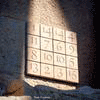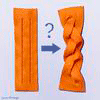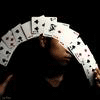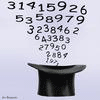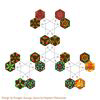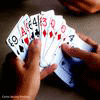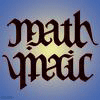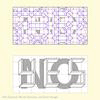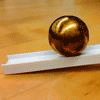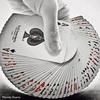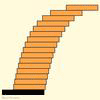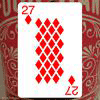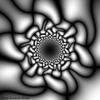Mathematics Awareness Month 2014: Mathematics, Magic, and Mystery
Navigate the Calendar
Astounding Infinity
The divergent series are the invention of the devil, and it is a shame to base on them any demonstration whatsoever.
The ominous words above have been attributed to Niels Abel, the famous Norwegian mathematician best known for having proved the impossibility of solving the general fifth degree polynomial equation. Abel goes on to say:
By using them, one may draw any conclusion he pleases and that is why these series have produced so many fallacies and so many paradoxes ...
Just how bad can it get? Behold:
This Numberphile video received about two million views in the first three months of 2014. Clearly, it struck a nerve.
Taking it Further
After watching the Numberphile video, the outrageous idea that the sum of all the positive integers is equal to –1/12 may seem, well, slightly less outrageous. But does the math really add up?
Before addressing that question, we suggest that you get hold of a pencil and a sheet of paper, and try your hand at the sort of “infinite sum arithmetic” performed in the video. For instance:
- Writing S1 = 1 – 1 + 1 – 1 + 1 – ···, carry out a term-by-term addition (with the second series shifted one place to the right) to calculate S1 + S1. You should find that 2S1 = 1, and so arrive at the same conclusion as stated in the video: S1 = 1/2.
- Writing S2 = 1 – 2 + 3 – 4 + 5 – ···, carry out a term-by-term subtraction to calculate S1 – S2. You should find that S1 – S2 = S2, and so arrive at the same conclusion as stated in the video: S2 = 1/4.
- The calculations in the first two exercises should give you food for thought. On the one hand, they support the conclusions reached in the Numberphile video. On the other, they demonstrate that something else might have happened: What if two different calculations for an infinite sum yielded two different values? Can this happen?
- Here is a new sum: Write S0 = 1 + 1 + 1 + 1 + 1 + ···. As in the video, write S = 1 + 2 + 3 + 4 + 5 + ···. Deduce that S + S0 = S – 1, and conclude that S0 = –1.
- Having calculated S + S0, now verify the difference S – S0 = S. Conclude that S0 = 0. That’s right: You have shown S0 = 0 and S0 = –1. See problem 3.
The point of these exercises is not to refute the claims in the Numberphile video, but rather to cast some doubt on the type of arithmetic being performed.
The most fundamental error committed in the video has not yet been addressed. It is the simple act of writing the equation
The equation implicitly declares that the infinite sum is equal to some number, a number that we name S. But mathematicians agree that the sum above is not, in fact, equal to any number. Not –1/12, and not anything else. The infinite sum is an example of what mathematicians (including Abel) call a “divergent series.”
The Underlying Mathematics
The issues brought up in the Numberphile video are deep. But they are not new. In the mid 16th century, the great Leonard Euler deduced that S = –1/12. It took another century for mathematicians to work out the devilish details.
Today, a college or university student majoring in mathematics will work through most of the details, typically in the third or fourth year of the major. While it is not possible to do all of that here, we will attempt to hit the highlights (and we encourage those who are interested to pursue these ideas).
First, what do we even mean by an infinite sum? It’s not obvious. In essence: Add the first two terms, then the first three terms, then the first four terms, and so on. If these partial sums approach a unique finite number, then the infinite sum is said to converge to that number. That number is the value of the infinite sum. In more formal language: an infinite sum, or series, is defined as the limit of its partial sums, provided the limit exists.
In the case of the series S1 = 1 – 1 + 1 – 1 + 1 – ···, the partial sums are 1, 0, 1, 0, 1, 0, ... They do not approach a unique value, but rather oscillate between two values. This means the series does not converge, or as a mathematician would say: the series diverges. It does not equal 1/2. Since the entire demonstration provided in the Numberphile video is contingent upon S1 being equal to 1/2, the entire argument falls apart. It is simply not true that the sum S of the positive whole numbers is –1/12.
But the story is considerably more interesting than this. (After all, these divergent series are the work of the devil!) The Numberphile video mentions that physicists use the “fact” that S is –1/12. It is used in string theory, and in quantum calculations. How can it be that the entire derivation is bunk?
Well, it is not exactly bunk. While the infinite series S = 1 + 2 + 3 + 4 + ··· diverges, it so happens that there is a very important function on the set of complex numbers called the Euler-Riemann zeta function. For any number whose real part is greater than 1, the zeta function can be defined as an infinite series. That is, given a complex number s, there is a convergent infinite series ζ(s). And while the underlying series will diverge for any complex number whose real part is 1 or lower, the zeta function can be defined differently at such points (except at its lone pole: 1) through a process called analytic continuation. The zeta function still assumes a value at every complex number other than 1, but that value only corresponds to the infinite series if the real part of the number exceeds 1.
It so happens that when this series, the series on which the Riemann zeta function is based, is formally evaluated at the number –1, it becomes the series S of positive whole numbers: the series from the Numberphile video. It also so happens that the value of the Riemann zeta function ζ(–1), = –1/12. In other words, even though S is a divergent series, if it were to have a value, –1/12 would be a sensible one. It is the only value that agrees with the Riemann zeta function. That is why, in a nutshell, the physics seems to like the value –1/12.
Now that is a mouthful. But unfortunately, there is no way around it. This is heady stuff, worked out over centuries by the brightest mathematical minds. If you are new to the topic of infinite sums and the complex numbers, suffice it to say that many fascinating discoveries lie before you should you choose to pursue them.
Several gifted expositors have gone to great lengths to set the Numberphile record straight. Evelyn Lamb, in her Scientific American blog, made a thoughtful post. When it comes to talking in general terms about divergent series, Richard Ewles, in a recent blog post, issued an “infinite series health and safety warning.” He discusses a fundamental fact about infinite series, well known to mathematicians, that strikes most non-mathematicians as outrageous and offensive: A conditionally convergent infinite series can be made to sum to any desired number by simply rearranging its terms!
For more on the Euler-Riemann zeta function and the formal series on which it is based, Dr. Skyskull has an interesting post, as does Terence Tau.



